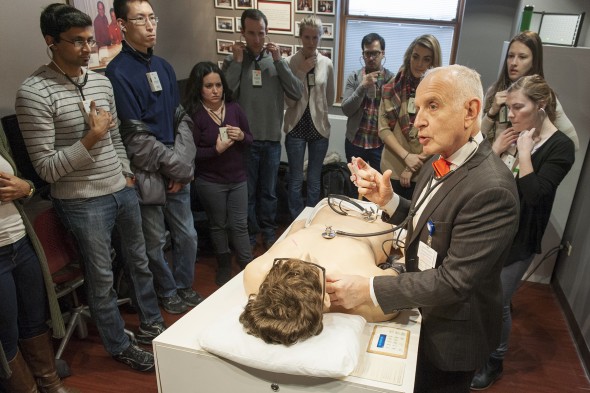Teaching medical students about the heart through simulations

George Kondos demonstrates a cardiovascular physical exam on Harvey, a life-size mannequin. Photo: Roberta Dupuis-Devlin
George Kondos has taught more than 2,000 UIC medical students how to perform the cardiovascular physical exam.
He’s had a little help from a very smart friend.
Kondos, vice chair of the department of medicine, says most physicians can identify, at most, about 10 percent of the most common heart sounds and murmurs.
“Most recently graduated medical students and early career doctors also have difficulty identifying heart sounds and murmurs,” Kondos said.
Don’t blame them, though. “Most medical students just won’t be exposed to all the different kinds of heart diseases during their four years at medical school,” he explained.
Early in his career as a cardiologist at UIC, Kondos wondered how to fill this gap, and came up with an answer: Harvey.
Developed by UIC College of Medicine alum Michael Gordon (class of ‘61), Harvey is a life-size mannequin able to simulate more than 30 cardiac diseases through heart sounds and life-like pulses in the neck and chest. Kondos called Gordon in 1991 to see if he could get a mannequin at UIC and, with the help of several benefactors, the medical school received a Harvey of its own.
In turn, Gordon asked Kondos to help develop cardiovascular simulation curricula. Kondos joined a group of nationally known cardiologists who met regularly to develop simulation-based technologies. The group helped create computer-based instruction tools to help students learn bedside skills, listen to heart sounds and murmurs, and read an electrocardiogram.
Kondos is chair of the college committee on instructional appraisal that oversees the medical education curriculum. Teaching medical students to master the art and science of the physical exam is something he is serious about.
“Students need to know a certain amount of information, but my real job is to instill in them a few very important concepts that will help shape their practice of medicine and help them take care of patients better,” he said.
“One of these concepts is the idea that the history and physical exam are what help you make the diagnosis. The laboratory studies are just used to confirm your diagnosis.”
Another of Kondos’ mantras: “You have to know what you expect to hear when listening to a patient’s heart before you can hear a particular heart sound or murmur.”
In addition to the UIC Award for Excellence in Teaching, Kondos received the College of Medicine Faculty Teaching Award and seven department of medicine’s Excellence in Teaching Award, selected by the internal medicine residents.
“It’s less important nowadays that students memorize facts, because they can look anything up instantly,” he said.
“What I need to teach them is how to analyze the information they have at their fingertips and how to apply the information to meaningful patient care.”
